Me: “I might write a blog about the puffins. Working title: ‘Our Feathered Friends in the North’.”
The Man of Kent: “I was thinking, ‘We’re off to see the puffins, the magical puffins of Farne.’ But ‘Our Feathered Friends in the North’ is good too.”
Tynemouth, June 2024
Pleasingly musical though the Man of Kent’s suggestion was, I decided to stick with my idea. He was on to something with the word ‘magical’ though.
The scene of our conversation was Platform 2 craft ale bar at Tynemouth Metro station. The Man of Kent and I were on one of our regular pilgrimages to the North to visit our lovely family and friends there, and had stopped for a pre-dinner beverage. Usually we stay in Newcastle city centre but this time, we decided to stay in Tynemouth for a whole week, because it was June and the Man of Kent fancied a bit of summer at the seaside.
[Brief aside – the collection of micropubs that live on the platforms at Tynemouth, Whitley Bay and Monkseaton metro stations delight the Man of Kent whenever we go to the North East coast. If you’re in the area, do try out the Left Luggage Room at Monkseaton and The Ticket Office at Whitley Bay, as well as Platform 2.]
It was our last evening in Tynemouth, and we were talking about all the things we had done on our trip. One of the highlights had been our visit to the Farne Islands. Going to the Farne Islands to see the puffins had been a long-held ambition of the Man of Kent. Indeed, it was one of the things he was determined to do on this trip North. Normally I would hesitate to use the word ‘magical’ to describe something, preferring to reserve the word for things that truly deserve the meaning of it, but honestly? The puffins were exactly that. So today, here’s a whole post about the magical puffins of Farne.
Preparations
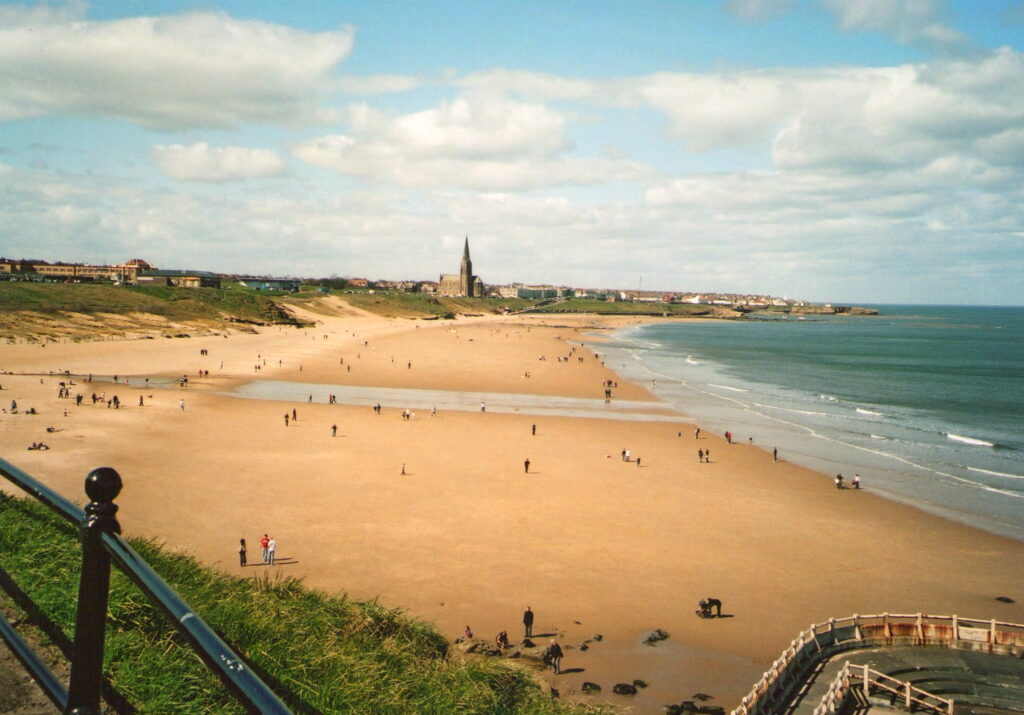
As the name suggests, The Man of Kent grew up in Kent, a land of generally warm temperatures, sunshine and boiling hot summers. Consequently, he is very much a summer guy. He will happily bake outside watching Kent play cricket at Canterbury, or on his allotment, or in the garden, whilst I lurk vampirically in the shade or indoors, patiently waiting for Autumn to arrive. He is also a man who has firm views about what summer should be like. For him, summer must involve things like sunshine, heat, cricket, beaches, barbeques, drinking beer outside, and frolicking about in shorts and sandals. Conversely, summer should not involve things like rain, cagoules, wellies, jumpers or gloves.
You would never think he had grown up in England to talk to him, but you’ve got to admire his optimism.
Watching him pack for this trip, you would also never think he had decades of experiences of visiting the North East at any time of year.
As I was putting my winter gloves and a sweatshirt into the suitcase, the Man of Kent was merrily choosing which shorts and t-shirts to take. I reminded him that we were going to Tynemouth, not Barbados. He reminded me that it was June – summer! – so shorts would definitely be required. I suggested that the BBC weather forecast was somewhat pessimistic, and perhaps he should pack a jumper – which I had dutifully laundered for him – just in case. He scoffed at the idea – he wouldn’t need to wear such a garment, especially in summer! On departure day, I asked if he would be taking a coat. No need, he assured me – he would be taking his pack-a-mac, which would be all he needed to withstand any piffling little rain shower that the North East might produce, in summer.
Reader, I tried.
In Tynemouth, after a couple of days of, admittedly unseasonably chilly temperatures, during which I was informed that it was “bloody freezing,” “ridiculously cold” and that “you would not believe it was summer” approximately once every five minutes, the Man of Kent realised that his holiday wardrobe was not ‘puffin-ready’. The BBC weather forecast gloomily predicted grey skies, rain, and temperatures no higher than 13 degrees Celsius (in summer). But The Man of Kent was not about to let such trifles stop him getting to the Farne Islands. Armed with a new, hastily bought hoodie and his trusty pack-a-mac, we consulted the weather forecast, divined the day least likely to completely piss it down, and booked tickets for a boat trip to Farne
Off to Farne
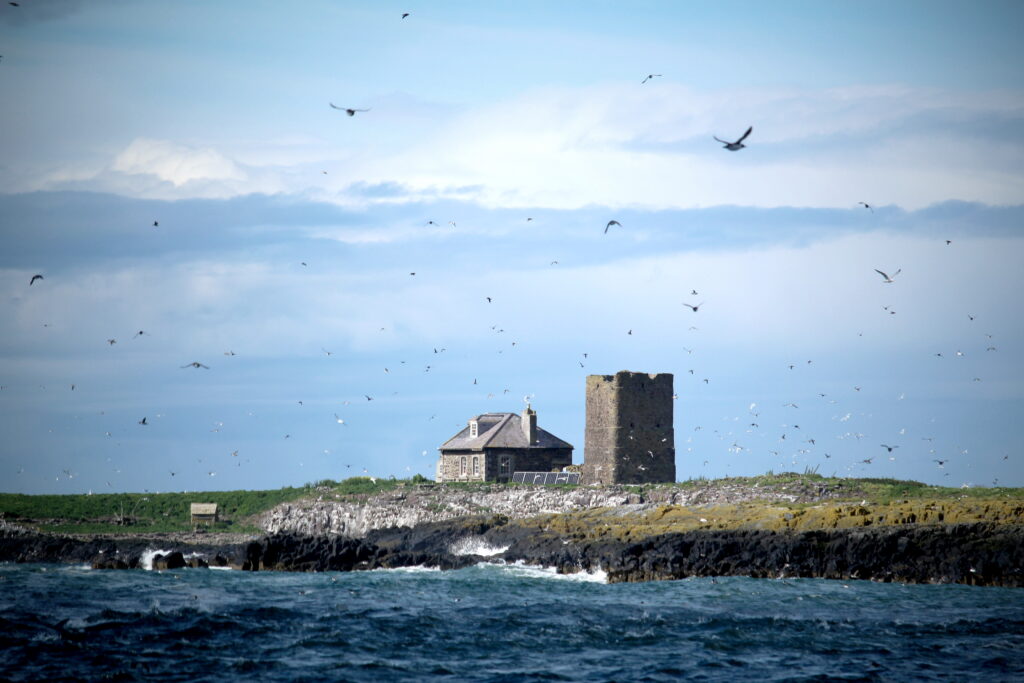
The Farne Islands lie in the North Sea, about 2 miles off the coast from Seahouses and 7 miles from the island of Lindisfarne, a.k.a Holy Island. There are about 15 to 20 islands in the Farne group, including Inner Farne, Staple and Longstone. Once home to St Cuthbert, and currently home to 23 different species of seabird, 43,000 pairs of puffins, and thousands of seals, the Farne Islands are an exciting destination for animal lovers, history buffs and wildlife photographers alike. The National Trust manages the islands, and several boat companies run day trips to them from Seahouses. We booked an Inner Farne landing trip with Billy Shiels.
Inner Farne is open to visitors from April to October. Weather and tides permitting, the crew will land you on the island itself, where you can stand right next to the birds and visit the Chapel of St Cuthbert and Prior Castell’s Tower. When we picked up our tickets from the booking office at Seahouses Harbour, the lady warned us that the crew “will do their best to land you on the island, but there’s big waves today so they might not be able to” – adding an exciting frisson of jeopardy to our trip. But safety is paramount; as well as ensuring they can land you on the island, the crew have to be sure they can get you safely back to shore again. No one wants to be stranded on a remote island in the middle of the North Sea, in summer or not!
Undaunted, we boarded our boat, the Glad Tidings III, a small craft with no roof cover, as threatening grey clouds started curling over the harbour. Setting sail, it was us vs the weather. On the way out, the boat bounced up and sploshed down on the heaving sea like a watery rollercoaster, with rain and sea spray sloshing over everyone and everything. If we wanted to see puffins, clearly we were going to have to earn it by defeating the elements first. Approaching Inner Farne on thrashing waves, the crew informed us that they could land us (hooray!), but it would have to be a short visit to be sure we could get safely back to shore.
One of our skippers, Bobby, was a proper Geordie whose voice, manner and accent reminded me of my Granda. Bobby chatted to everyone, dead friendly, and – like my Granda – made no allowances for anyone whose ear might not be fully attuned to the Geordie dialect. As one international visitor was attempting to step off the precariously swaying boat onto the Inner Farne jetty, he appeared quite perplexed by Bobby’s enthusiastic instructions to “Gan on aheed, son! Just gan on aheed!” [Translation: “Do feel free to carry on ahead, old chap.”] My Granda would have loved everything about this trip. Listening to Bobby’s proper Geordie voice, I felt Granda was with us in spirit.
Ganning on aheed, it was off the boat and up the jetty, drenched, with 45 minutes to see puffins.
Puffins!

You might be cold, soaked to the skin and barely able to feel your hands, but the thing is, once you see the puffins, suddenly you don’t care about how wet you are, the weather, or much else, actually. They are just breath-taking.
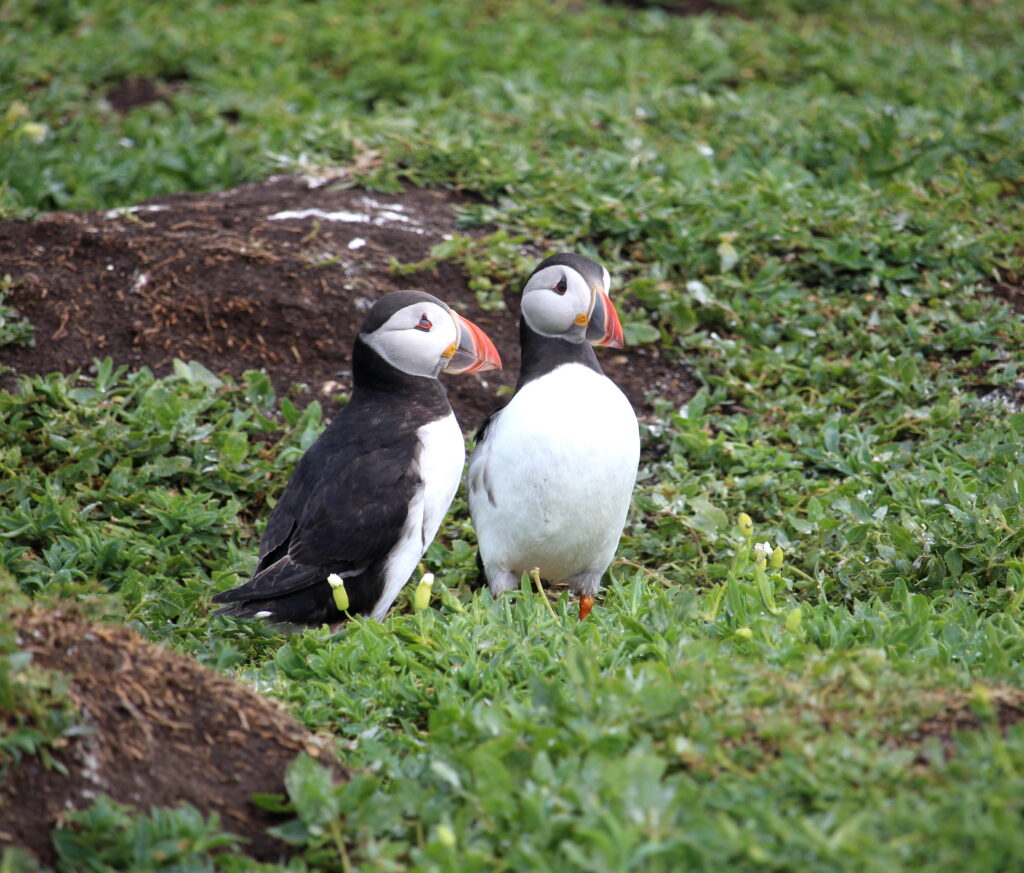
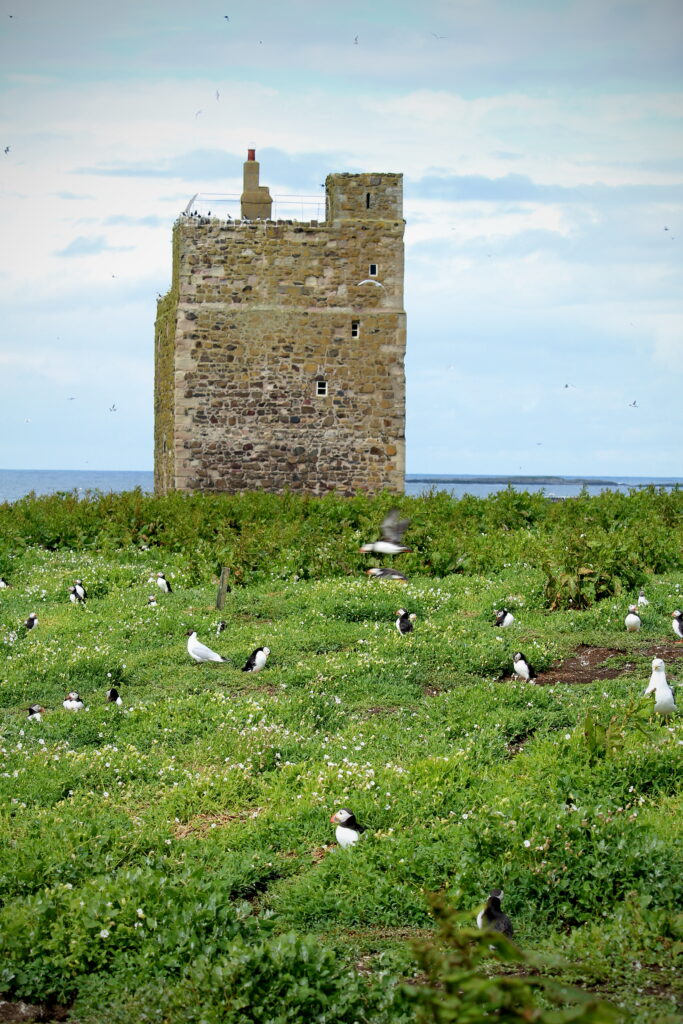
How to describe the majestic beauty of this tiny island? Everywhere, everywhere, there are thousands of birds – on the ground, on the rocks, in the air. The noise is incredible – a cacophony of different calls, chirrups and screeches coming together with the howling wind and roaring sea to create a haunting avian orchestra. On the grass in front of you, fat, cuddly puffins waddle about adorably, nimbly diving into their little puffin burrows to dodge the horrid gulls that try to mug them for food. More puffins perch happily on the rocks, contentedly stuffing their gorgeous little beaks with sand eels they have plucked from the billowing waves below. In the air, countless more birds flying and swooping too fast to be seen – puffins, gulls, kittiwakes, arctic terns and more. As I stood there, awestruck and wonder-filled, I thought this must be what David Attenborough feels like when he’s doing a documentary. Indeed, you want David Attenborough to be there beside you narrating the scene in his familiar, reverent tones, because you just can’t put the magnificence in front of you into words. I took loads of photos, although I knew with every click that no picture could do justice to the beauty I was seeing in real life. Those 45 minutes felt like 30 seconds and I will remember that island forever. Magical, indeed.
Famous Inner Farne residents

The puffins are not the only famous residents of Inner Farne. It was also home to one of Northumbria’s most famous religious figures, St Cuthbert.
St Cuthbert was born and raised in Northumbria in the 7th century CE. A warrior in his youth, he became a monk aged 17. Much loved and revered, he served as Prior of Lindisfarne for 12 years, before choosing to live as a hermit on Inner Farne. Towards of the end of his life he left hermitage to become Bishop of Lindisfarne, but returned to Inner Farne to live out his final years. Cuthbert was originally buried on Lindisfarne, but repeated Viking raids led to his fellow monks exhuming his body and taking it to the mainland for safety. After years of travelling around the country looking for a secure final resting place for Cuthbert, the monks settled on Durham. There are various stories about how the monks came to select Durham, my favourite being the Dun Cow legend. Cuthbert’s shrine became part of Durham Cathedral, and can be visited today.
The Man of Kent remarked that it must have been a lonely life for St Cuthbert on Inner Farne but I couldn’t help thinking it didn’t sound so bad. I imagine it went something like: get up, pray, read gospels while looking at puffins, have lunch, go outside and pat a puffin, do some monk admin, hope the Vikings don’t raid the island tomorrow, say goodnight to puffins, pray, and go to bed. Rinse and repeat. Doesn’t sound dreadful. Although as the Man of Kent pointed out, it would probably be “bloody freezing” all the time.
Guillemots and Staple Island
Our allotted time over, we headed back to the boat. By this time, the sun had come out. For the rest of our trip, it was glorious blue skies and sunshine. The sea was still impressively choppy though, so my approach to photography was very much ‘brace self, point, click and hope for the best’.
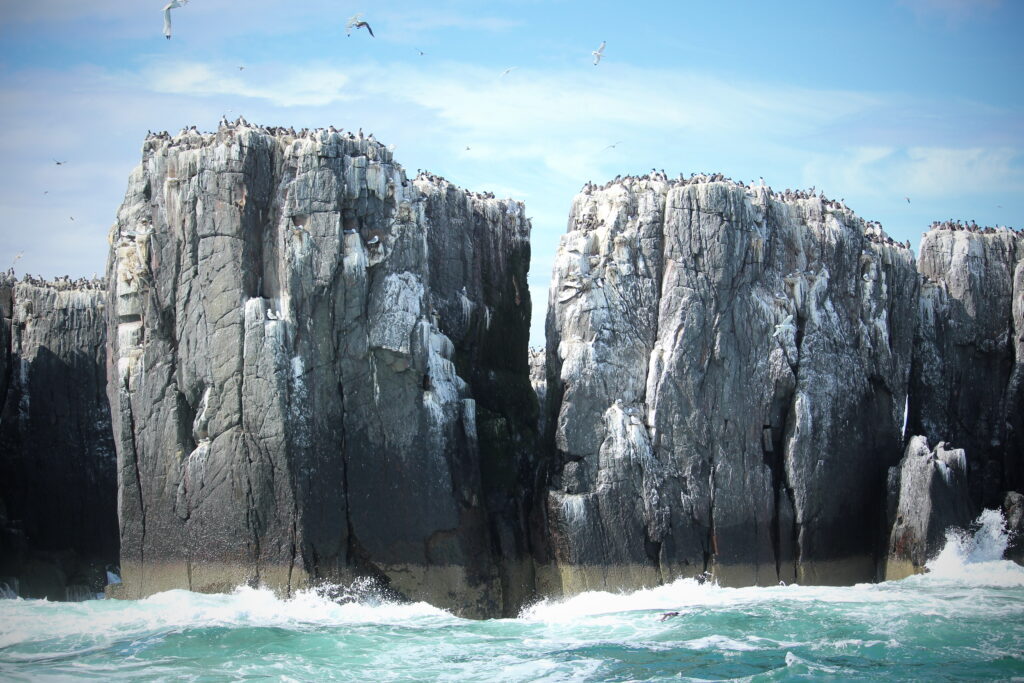
From Inner Farne, our crew sailed us round the other Farne Islands, providing full commentary on the seabirds and history of the area. We saw thousands of guillemots standing proudly on the precipitous cliffs of Staple Island. Our skipper informed us that about three weeks after hatching, the brave guillemot chicks have to literally jump off the rocks into the sea below so that they can start growing their flight feathers and become independent. It sounds lethal, but apparently this strategy works for many types of seabirds. For this reason, baby guillemots are called jumplings. Just as adorably, baby puffins are called pufflings.
Grey seals
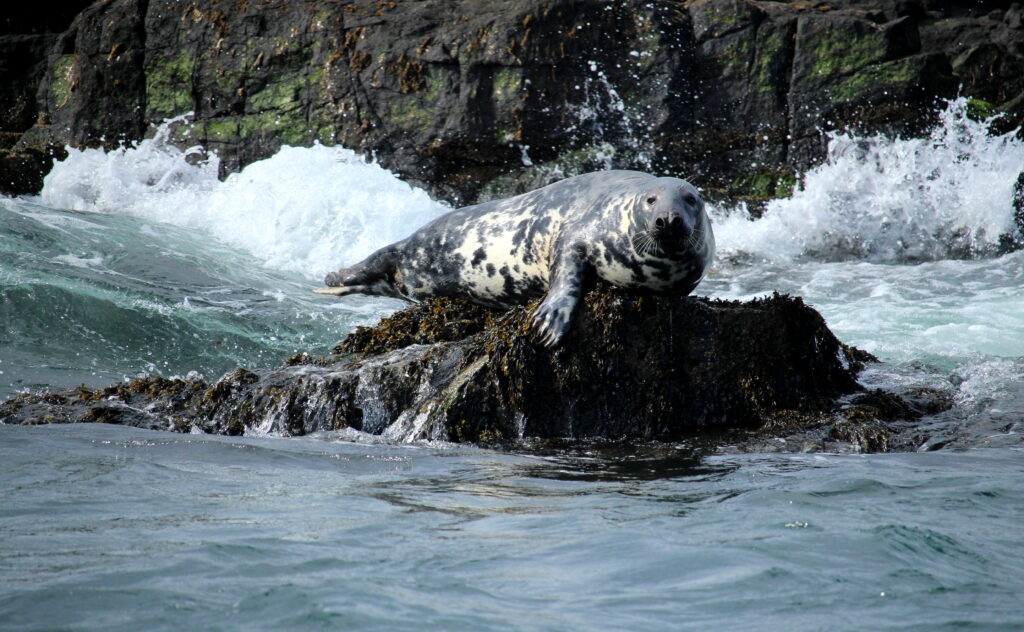
Moving on from Staple Island, we saw kittiwakes, shags, and enormous grey seals lolling around on the rocks of the outer Farnes. The Farne Islands are one of the most important grey seal sites in the country, with around 2,000 seal pups born there every Autumn according to the National Trust.
Longstone Lighthouse and Grace Darling
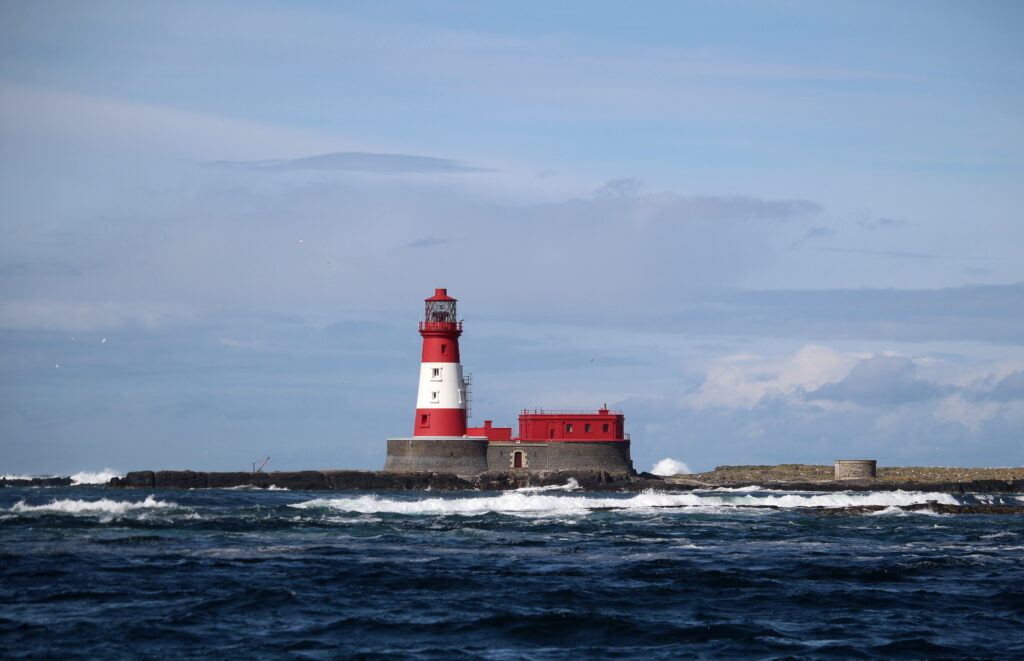
Finally, we sailed out to Longstone Lighthouse on Longstone Rock, the home of Grace Darling. Grace Darling is famous for her heroic rescue of nine passengers from the wreck of the steamer SS Forfarshire during a fierce storm in September 1838. The Forfarshire had run aground on Harcar Rocks, about one mile from Longstone Lighthouse. From the lighthouse window, Grace spotted survivors clinging to the rocks. She and her father to set out to rescue them, despite the treacherous conditions, and saved the lives of nine people. Instantly becoming a national heroine, Grace and her father were awarded gold medals from the Royal Humane Society.
Back to Seahouses
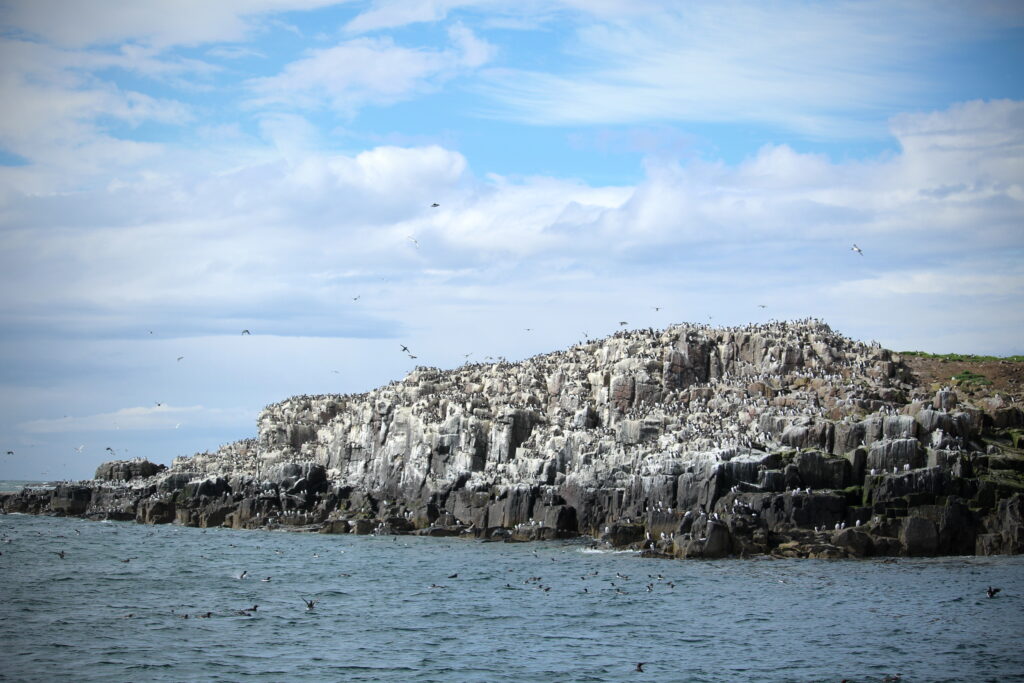
After that, it was back to Seahouses with not a raindrop in sight. We were a bit cold, a bit damp and tired from the sea air, but happy, smiling and full of love for the puffins and our other feathered friends of the Farne Islands. A truly magical trip, worth a drenching, and one I hope to make again in future. Do not miss visiting the Farne Islands if you’re ever in Northumberland.
And, regardless of the time of year, if you’re heading to the North East, pack a jumper and your big coat!

Leave a Reply